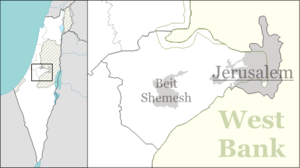Tzova
| Tzova צובה | |
|---|---|
|
| |
 Tzova | |
| Coordinates: 31°47′3.48″N 35°7′10.55″E / 31.7843000°N 35.1195972°ECoordinates: 31°47′3.48″N 35°7′10.55″E / 31.7843000°N 35.1195972°E | |
| District | Jerusalem |
| Council | Mateh Yehuda |
| Affiliation | Kibbutz Movement |
| Founded | 19 October 1948 |
| Founded by | Palmach soldiers |
| Population (2015)[1] | 651 |
| Website | www.tzuba.org.il |

Tzova (Hebrew: צוֹבָה), also Palmach Tzova (Hebrew: פלמ"ח צובה) or Tzuba is a kibbutz in central Israel. Located in the Judean Hills, on the western outskirts of Jerusalem, it falls under the jurisdiction of Mateh Yehuda Regional Council. In 2015 it had a population of 651
History
Tel Tzova was the site of an ancient Jewish settlement in the days of King David according to 2 Samuel 23:36. According to some scholars it can be dated back even further to the time of Joshua Bin-Nun, based on Joshua 15:59 in the Septuagint.
In 1170, a Crusader fortress, Belmont, was built there to guard the route to Jerusalem. Belmont was conquered by Saladin in 1191.
The adjacent Arab village of Suba was the scene of fierce fighting during the 1948 Arab–Israeli War due to its strategic location overlooking the road to Jerusalem. In late 1947 and early 1948, irregular forces of the Egyptian Muslim Brotherhood stationed in Suba repeatedly attacked Jewish traffic on the main highway from Tel Aviv to Jerusalem. The village was conquered by the Palmach during the night of July 12–13 as part of Operation Danny. Most of the inhabitants fled before the fighting and did not return.[2] Most moved to Kalandia or Amman, Jordan, although some moved only 1 km away to the nearby village of Ein Rafa – where they and their descendants live to this day as Israeli citizens.[3]
In October 1948 a group of Palmach veterans established Kibbutz Misgav Palmach 1 km south of Suba, which was later renamed Palmach Tzova.[4]
Economy
The kibbutz's main income comes from its glass factory: Oran Safety Glass (OSG), which produces laminated, tempered and bulletproof security glass.[5] It was reported that OSG has begun "manufacturing a bullet-resistant windshield with a touch screen embedded in it" and that the "screen is connected to the vehicle’s multimedia system, so it may be used to display maps, live feeds from the day or night vision cameras mounted on the vehicle, and other video options".[6]
There is also a hotel overlooking the Jerusalem Hills, a children's amusement park ("Kiftzuba"), orchards, vineyards, a winery and a chocolate workshop. The kibbutz also hosts a residential Hebrew language ulpan.[7] Other sources of income – located away from the kibbutz – are the dairy farm (located in kibbutz Tzora) and cotton fields. As the kibbutz is based on socialist principles, the salaries of kibbutz members who work independently in the city are automatically paid into the communal purse.
Archaeology
In 1999, a cave believed to have been the cave of John the Baptist was discovered by Reuven Kalifon during archaeological excavations in the area of the kibbutz orchards, not far from Ein Karem, St. John's traditional birthplace. In the 4th and 5th century CE, the cave was sanctified and used by Byzantine monks as a Christian holy place. On its walls are some of the earliest drawings known in local Christian art. Structures outside the cave date to the Hellenistic period (2nd century BCE) and indicate that the cave was used as both a water reservoir and a place for bathing. Water was collected from the valley and channeled into the cave via a water-filtering basin. A sluice allowed some of the water to be channeled from the filtering basin into the fields.
Archaeologists discovered a flight of 7 steps leading to an underground, man-made rectangular pool of water. Thousands of pottery shards, possibly the remnants of small water jugs used in the baptismal ritual, were found at the site. [8]
See also
References
- ↑ "List of localities, in Alphabetical order" (PDF). Israel Central Bureau of Statistics. Retrieved 16 October 2016.
- ↑ Morris, Benny (2004). The Birth of the Palestinian Refugee Problem Revisited. Cambridge University Press. p. 436. ISBN 978-0-521-00967-6.
- ↑ M.S.M. Rumman (2000) Suba - Remembering a Village in the Jerusalem Area
- ↑ Khalidi, Walid (1992), All That Remains: The Palestinian Villages Occupied and Depopulated by Israel in 1948, Washington D.C.: Institute for Palestine Studies, ISBN 0887282245
- ↑ Search for the Sacred; in Israel, Archeology Fuels Believers' Passions and Provokes Skeptics in a Sharp Debate without End Newsweek, 30 August 2004
- ↑ http://www.israeldefense.co.il/en/content/future-here-touch-screen-bullet-resistant-windshield
- ↑ Ulpan List Kibbutz Ulpan
- ↑ Cave called John the Baptist BICOG
External links
- Official website
 Media related to Tzova at Wikimedia Commons
Media related to Tzova at Wikimedia Commons